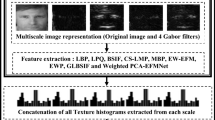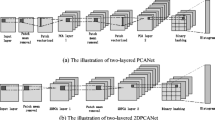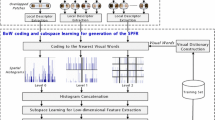Abstract
A Sparse Principal Component Analysis Network (SpPCANet) based feature extraction is proposed here for 3D face recognition. The network consists of three basic components: (1) Multistage sparse principal component analysis filters, (2) Binary hashing, and (3) Block-wise histogram computation. Here, the sparse principal component analysis is used to learn multistage filter banks at the convolution stage, which is followed by binary hashing for indexing and block-wise histogram for pooling. Finally, a linear support vector machine (SVM) is used for classifying the features extracted by SpPCANet. The proposed network SpPCANet is a lightweight deep learning network. Three well-known 3D face databases, namely, Frav3D, Bosphorus3D, and Casia3D, are used for validating the proposed system. This proposed network has been extensively studied by varying different parameters, such as the number of filters at the convolution layer and the size of filters at the convolution layer and size of non-overlapping blocks at the pooling layer. Handling all types of variation of faces available in Frav3D, Bosphorus3D, and Casia3D databases, the system has acquired 96.93%, 98.54%, and 88.80% recognition rates, respectively.











Similar content being viewed by others
References
Alain G, Bengio Y (2014) What regularized auto-encoders learn from the data-generating distribution. J Mach Learn Res 15:3743–3773
Alyuz N, Gokberk B, Dibeklioglu H, Savran A, Salah AA, Akarun L, Sankur B (2008) 3D Face Recognition Benchmarks on the Bosphorus3D Database with Focus on Facial Expressions. In: Schouten B, Juul NC, Drygajlo A, Tistarelli M (eds) Biometrics and Identity Management. BioID 2008. Lecture notes in computer science, vol 5372. Springer, Berlin Heidelberg, pp 57–66
Bagchi P, Bhattacharjee D, Nasipuri M (2015). 3D face recognition using surface Normals. In: Proc. IEEE region 10 conference, TENCON - 2015. https://doi.org/10.1109/TENCON.2015.7372819
Besl PJ, McKay ND (1992) A method for registration of 3-D shapes. IEEE trans. Pattern anal. Mach. Intell. (T-PAMI) 14(2):239–256
BOSPHORUS3D3D: http://bosphorus.ee.boun.edu.tr/default.aspx
Bruna J, Mallat S (2013) Invariant scattering convolution networks. IEEE trans. Pattern anal. Mach. Intell. (T-PAMI) 35(8):1872–1886
Chan TH, Jia K, Gao S, Lu J, Zeng Z, Ma Y (2015) PCANet: a simple deep learning baseline for image classification? IEEE Trans Image Process 24(12):5017–5032
Chandrakala M, Ravi S (2018) Effective 3D face recognition technique based on Gabor and LTP features. International Journal of Engineering and Advanced Technology (IJEAT) 8(2S):284–290
Chhatrala R, Jadhav D (2017) Gait recognition based on curvelet transform and PCANet. Pattern Recog. Image Anal 27(3):525–531. https://doi.org/10.1134/S1054661817030075
Chouchane A, Belahcene M (2015) 3D and 2D face recognition using integral projection curves based depth and intensity images. Int J Intell Syst Technol Appl 14(1):50–69
Chouchane A, Belahcene M, Ouamane A, Bourennane S (2014) 3D face recognition based on histograms of local descriptors. In: Proc. 4th international conference on image processing theory, tools and applications (IPTA), Paris, France. https://doi.org/10.1109/IPTA.2014.7001925
Cortes C, Vapnik V (1995) Support-vector networks. Mach Learn 20(3):273–297
Drira H, Amor BB, Srivastava A, Daoudi M, Slama R (2013) 3D face recognition under expressions, occlusions and pose variations. IEEE trans. Pattern anal. Mach. Intell. (T-PAMI) 35(9):2270–2283
Dutta K, Bhattacharjee D, Nasipuri M (2016). Expression and occlusion invariant 3D face recognition based on region classifier. In: Proc. 1st international conference on information technology, information systems and electrical engineering (ICITISEE), pp. 99-104. https://doi.org/10.1109/ICITISEE.2016.7803055
Dutta K, Bhattacharjee D, Nasipuri M (2019) 3D face recognition based on volumetric representation of range image. In: Chaki R, Cortesi a, Saeed K, Chaki N (eds) advance computing and Systems for Security. Advance in Intelligent Systems and Computing 883:175–189. https://doi.org/10.1007/978-981-13-3702-4_11
FRAV3D: http://www.frav.es/databases
Ganguly S, Bhattacharjee D, and Nasipuri M (2014). 2.5D face images: acquisition, processing and application. In Proc. ICC 2014 -computer networks and security, pp. 36-44
Ganguly S, Bhattacharjee D, Nasipuri M (2014) 3D face recognition from range images based on curvature analysis. ICTACT Journal on image and video processing 4(3):748–753. https://doi.org/10.21917/ijivp.2014.0108
Gilani SZ, Mian A (2016). Towards large-scale 3D face recognition. International Conference on Digital Image Computing: Techniques and Applications (DICTA)
Huang D, Du Y, He Q, Song W, Liu K (2016) Scene classification in high resolution remotely sensed images based on PCANet. Web Technologies and Applications, APWeb, Springer, Cham 9865:179–190. https://doi.org/10.1007/978-3-319-45835-9_16
Krizhevsky A, Sutskever I, Hinton GE (2012) ImageNet classification with deep convolutional neural networks. In: Proc. 25th international conference on neural information processing systems. Lake Tahoe, Nevada, pp 1097–1105
LeCun Y, Bottou L, Bengio Y, Haffner P (1998) Gradient-based learning applied to document recognition. In: Proc of the IEEE 86(11):2278–2324
Lee H, Grosse R, Rananth R, and Ng A Y (2009). Convolutional deep belief networks for scalable unsupervised learning of hierarchical representations. In: Proc. 26th Annu. ICML, pp. 609–616. https://doi.org/10.1145/1553374.1553453
Li B, Dong Y, Zhao D, Wen Z, and Yang L (2016). A PCANet based method for vehicle make recognition. In: Proc. 19th international conference on intelligent transportation systems (ITSC), IEEE. Pp. 2404-2409. https://doi.org/10.1109/ITSC.2016.7795943
Li C, Tan Y, Wang D, Ma P (2017) Research on 3D face recognition method in cloud environment based on semi supervised clustering algorithm. Multimed Tools Appl 6:17055–17073
Ng CJ, and Teoh ABJ (2015). DCTNet: a simple learning-free approach for face recognition. In: Proc. APSIPA, pp. 761–768. https://doi.org/10.1109/APSIPA.2015.7415375
Ouamane A, Belahcene M, Bourennane S (2013). Multimodal 3D and 2D face authentication approach using extended LBP and statistic local features proposed. In: Proc. European workshop on visual information processing (EUVIP), pp. 130-135
Parvathy SB, Naveen S, Moni RS (2014). A novel approach for multimodal face recognition system based on modular PCA. In: proc. 1st international conference on computational systems and communications (ICCSC), pp. 127-132. https://doi.org/10.1109/COMPSC.2014.7032634
Ratyal N, Taj IA, Sajid M, Mahmood A, Razzaq S, Dar SH, Ali N, Usman M, Baig MJA, Mussadiq U (2019). Deeply learned pose invariant image analysis with applications in 3D face recognition. Mathematical problems in engineering. https://doi.org/10.1155/2019/3547416
Schroff F, Kalenichenko D, and Philbin J (2015). FaceNet: a unified embedding for face recognition and clustering. In: Proc IEEE Conference on Computer Vision and Pattern Recognition (CVPR) https://doi.org/10.1109/CVPR.2015.7298682
Sghaier S, Farhat W, Souani C (2018) Novel technique for 3D face recognition using anthropometric methodology. International Journal of Ambient Computing and Intelligence 9(1):60–77
Soltanpour S, Wu QMJ (2017). High-order local Normal derivative pattern (LNDP) for 3D face recognition. International conference on image processing (ICIP). Pp. 2811-2815
Szegedy C, Liu W, Jia Y, Sermanet P, Reed S, Anguelov D, Erhan D, Vanhoucke V, and Rabinovich A (2015). Going deeper with convolutions. In: Proc IEEE Conference on Computer Vision and Pattern Recognition (CVPR) https://doi.org/10.1109/CVPR.2015.7298594
Tian L, Fan C, Ming Y (2015). Stacked PCA network (SPCANet): an effective deep learning for face recognition. In: Proc. IEEE International Conference on Digital Signal Processing, pp. 1039–1043. https://doi.org/10.1109/ICDSP.2015.7252036
Tibshirani R (1996) Regression shrinkage and selection via the lasso. J R Stat Soc Ser B Methodol 58(1):267–288 https://www.jstor.org/stable/2346178
Tong M, Chen Y, Zhao M, Bu H, Xi S (2019) A deep discriminative and robust nonnegative matrix factorization network method with soft label constraint. Neural Comput & Applic 31:7447–7475. https://doi.org/10.1007/s00521-018-3554-6
Tong M, Li M, Bai H, Lei M, Zhao M (2020) DKD–DAD: a novel framework with discriminative kinematic descriptor and deep attention-pooled descriptor for action recognition. Neural Comput & Applic 32:5285–5302. https://doi.org/10.1007/s00521-019-04030-1
Tong M, Zhao M, Chen Y, Wang H (2019) D3-LND: a two-stream framework with discriminant deep descriptor, linear CMDT and nonlinear KCMDT descriptors for action recognition. Neurocomputing 325:90–100. https://doi.org/10.1016/j.neucom.2018.09.086
Wang X, Ruan Q, Jin Y, and An G (2014). Three-dimensional face recognition under expression variation. EURASIP Journal on Image and Video Processing https://doi.org/10.1186/1687-5281-2014-51, 2014
Werghi N, Berretti S, Bimbo A D, Pala P (2013). Local descriptors matching for 3D face recognition. In: Proc. IEEE international conference on image processing (ICIP), Australia, pp. 3710-3714. https://doi.org/10.1109/ICIP.2013.6738765
Zeiler MD, Fergus R (2014) Visualizing and Understanding Convolutional Networks. In: Fleet D, Pajdla T, Schiele B, Tuytelaars T (eds) Computer Vision – ECCV 2014. Lecture notes in computer science. Springer, Cham. https://doi.org/10.1007/978-3-319-10590-1_53
Zhang L, Ding Z, Li H, Shen Y, Lu J (2014) 3D face recognition based on multiple Keypoint descriptors and sparse representation. PLoS One 9(6):e100120. https://doi.org/10.1371/journal.pone.0100120
Zhang Y, Geng T, Wu X, Zhou J, and Gao D (2018). ICANet: a simple cascade linear convolution network for face recognition. EURASIP Journal on Image and Video Processing https://doi.org/10.1186/s13640-018-0288-4, 2018
Zheng D, Du J, Fan W, Wang J, Zhai C (2016) Deep learning with PCANet for human age estimation. In: Huang DS, Jo KH (eds) international conference on intelligent computing (ICIC), lecture notes in computer science, springer. Cham. 9772:300–310. https://doi.org/10.1007/978-3-319-42294-7_26
Zou H, Hastie T (2005) Regularization and variable selection via the elastic net. J R Stat Soc Ser B (Stat Methodol) 67(2):301–320 https://www.jstor.org/stable/3647580
Zou H, Hastie T, Tibshirani R (2006) Sparse principal component analysis. J Comput Graph Stat 15(2):265–286. https://doi.org/10.1198/106186006X113430
Acknowledgments
The first author is grateful to the Ministry of Electronics and Information Technology (MeitY), Govt. of India, for the grant of the Visvesvaraya doctorate fellowship award. The authors are also thankful to CMATER laboratory of the Department of Computer Science and Engineering, Jadavpur University, Kolkata, India, for providing the necessary infrastructure for this work.
Author information
Authors and Affiliations
Corresponding author
Additional information
Publisher’s note
Springer Nature remains neutral with regard to jurisdictional claims in published maps and institutional affiliations.
Rights and permissions
About this article
Cite this article
Dutta, K., Bhattacharjee, D. & Nasipuri, M. SpPCANet: a simple deep learning-based feature extraction approach for 3D face recognition. Multimed Tools Appl 79, 31329–31352 (2020). https://doi.org/10.1007/s11042-020-09554-6
Received:
Revised:
Accepted:
Published:
Issue Date:
DOI: https://doi.org/10.1007/s11042-020-09554-6




